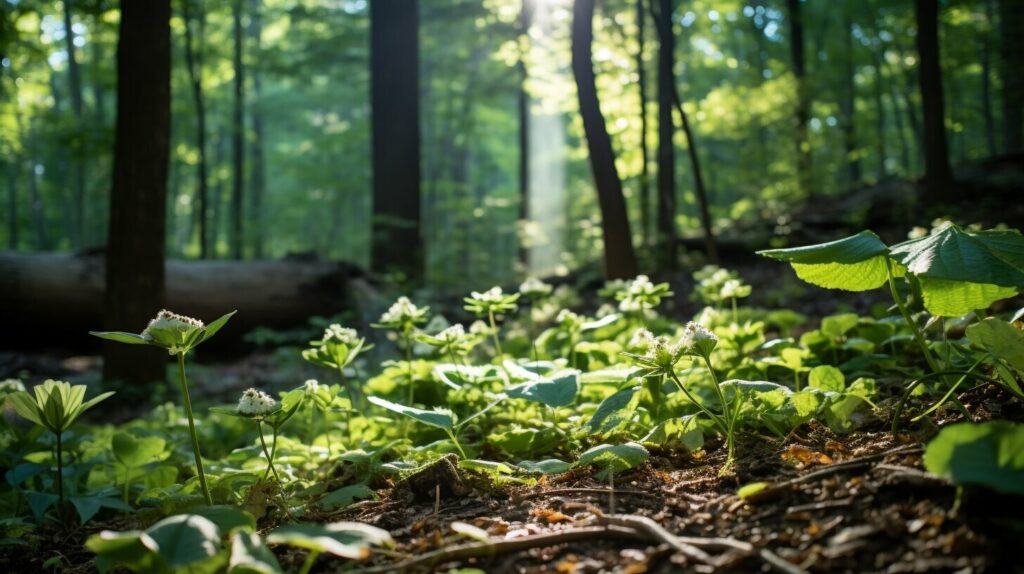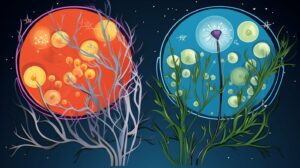Welcome to the world of botany! Plants have always been a fascinating subject for me. They can range from tiny mosses to towering redwoods, and each plant is unique in its own way. But have you ever wondered, are plants alive? This question may seem obvious, but the answer is much more complex than a simple yes or no.
Plant life is a complex concept that requires us to delve deeper into their biology. Plants are indeed living organisms, but they differ from animals in many ways. In this section, we will explore the plant kingdom and discuss the intricate nature of plant life and how it differs from other living organisms.
- Plants are living organisms that make up the plant kingdom.
- Plant life is complex and differs from other living organisms.
- In this section, we explore the plant kingdom and the intricacies of plant life.
Understanding Plant Biology and Growth
Botanical life is a fascinating subject that never ceases to amaze me. Plants are living organisms that possess unique cellular structures that allow them to perform vital functions such as photosynthesis and growth.
Plant biology is a branch of science that studies the anatomy, physiology, and biochemistry of plants. It encompasses the study of plant cells, organs, tissues, and systems and their roles in plant growth.
Photosynthesis is a critical process that enables plants to convert sunlight into energy by synthesizing glucose from carbon dioxide and water. This process requires the presence of chlorophyll, a pigment found in plant cells that absorbs light energy and converts it into chemical energy.
Plant growth is a remarkable phenomenon that involves cell division, elongation, and differentiation. It occurs in response to various internal and external factors, including light, temperature, water, and nutrients. Plant hormones also play a crucial role in regulating plant growth, controlling the timing and extent of various developmental processes.
| Plant Anatomy: | roots, stems, leaves, flowers, fruits |
|---|---|
| Plant Physiology: | photosynthesis, respiration, transpiration, hormone regulation |
| Plant Biochemistry: | metabolic pathways, enzymes, chemical compounds |
Understanding plant biology and growth is essential for improving agricultural practices, developing new medicines, and mitigating environmental impact. Studying plant biology can also inspire innovative technologies and designs that mimic nature’s ingenuity.

As we explore the fascinating realm of plant life further, we will uncover the diversity of living plant species and their remarkable adaptability and survival strategies.
Exploring the Diversity of Living Plant Species
Plants are incredible living organisms that come in a vast array of species. From towering trees to delicate flowers, each plant has its unique characteristics and adaptations that make them special. Let’s take a journey through the plant kingdom and discover the incredible diversity of living plant species.

There are over 300,000 known plant species on earth, and botanists are still discovering new ones every day. Some of the most well-known types of plants are flowering plants, which produce vibrant and fragrant blooms. However, there are also non-flowering plants, such as ferns and mosses, that have their unique features and reproductive strategies.
| Type of Plant | Description |
|---|---|
| Flowering plants | These are the most abundant plants on earth and produce flowers that attract pollinators. |
| Ferns | These ancient plants have fronds that unfurl and reproduce via spores. |
| Mosses | These small, non-vascular plants thrive in damp environments and reproduce via spores. |
| Carnivorous plants | These fascinating plants have adapted to feed on insects and other small animals to supplement their nutrient-poor environments. |
Each plant species has unique adaptations that allow them to survive in diverse environments. For example, cacti have evolved to store water in their thick stems, allowing them to survive in arid desert conditions. Similarly, orchids have adapted to rely on specific pollinators, such as bees or moths.
Exploring the diverse world of living plant species is a fascinating journey that never ends. Each plant has its unique story, and discovering them is a true adventure.
Unraveling the Secrets of Plant Survival
Plants have evolved a wide range of remarkable strategies to survive in a variety of environments. Over time, they have developed adaptations for obtaining nutrients, coping with harsh conditions, and protecting themselves against predators.
One of the most fascinating adaptations of plants is their ability to obtain nutrients from their surroundings. The roots of plants have evolved to absorb water and minerals from the soil. Some plants have even developed mutualistic relationships with fungi to enhance nutrient absorption. For example, mycorrhizae fungi form a symbiotic relationship with plant roots, extending their reach to areas beyond what roots can access.
In addition to acquiring nutrients, plants must also adapt to harsh conditions such as drought, high salinity, and extreme temperatures. Some plants, like succulents, have adopted the ability to store water in their leaves, stems, and roots to survive in arid environments. Others, like cacti, have developed thick, waxy coatings to prevent water loss.
Plants also have developed various defense mechanisms to protect themselves against predators. Many plants produce toxins to deter animals from feeding on them, while others have evolved thorns, prickles, or spines for physical defense. Some carnivorous plants such as venus flytraps and pitcher plants have even developed specialized structures to trap and digest insects for nutrients.
The ingenuity of plant survival strategies continues to fascinate scientists and nature enthusiasts alike, constantly revealing new insights into the remarkable adaptability of plant life.

The Interconnectedness of Plant Life
As I’ve explored the world of plant life, I’ve learned that these living organisms play an integral role in the interconnected web of life. They not only contribute to the beauty of our environment, but they also sustain ecosystems and provide essential resources for other living organisms.
One of the most crucial roles plants play is through photosynthesis, a process that generates oxygen and organic compounds. This process is essential to the survival of many other living organisms, including humans. In fact, plants are responsible for producing over 50% of the oxygen we breathe. This incredible contribution to our world cannot be understated.
But plants aren’t just passive contributors to the environment. They are also critical to the food chain as producers of their own food through photosynthesis. They provide nourishment for a wide range of organisms, from tiny insects to large mammals, including us. Without plants, many animal species would struggle to survive and, in turn, disrupt entire ecosystems.
Plant life also plays a vital role in soil health, providing essential nutrients and aiding in water retention. They contribute to the creation and maintenance of habitats for animals, insects, and microorganisms. Without plants, our world would be almost unrecognizable, and a significant chain of biological processes would be disturbed.

As I reflect on the incredible role plants play in our world, I’m reminded of just how interconnected all living organisms are. The plant kingdom is not just a fascinating and diverse realm to explore, but it’s also essential to the continuation of life on our planet. Plants may seem stationary and unchanging, but they are fundamental living organisms that contribute to the rich tapestry of life.
Conclusion
As a professional copywriting journalist, I have explored the captivating world of botany and answered the question, “Are plants alive?” We have learned that plants are living organisms that possess unique characteristics and mechanisms to sustain themselves. Their diverse forms and growth strategies, as well as their remarkable ability to survive and contribute to the environment, make them a fascinating subject to study.
Why the Plant Kingdom is Worth Exploring
The vast plant kingdom represents a rich and diverse realm with endless possibilities for exploration. From the smallest mosses to towering trees, each plant species has its own unique adaptations and survival strategies. By studying the plant kingdom, we gain a deeper understanding of the complex web of life and the essential role of plants in sustaining ecosystems.
Final Thoughts
As I conclude this article on the mysteries of plant life, I am reminded of the wonder and awe that nature inspires in us. The plant kingdom, in particular, offers a glimpse into the intricate mechanisms of life and the beauty of diversity. As we continue to explore and appreciate this fascinating realm, let us also remember to celebrate and protect the vital role that plants play in sustaining our planet.
FAQ
Q: Are plants alive?
A: Yes, plants are living organisms.
Q: What is plant life?
A: Plant life refers to the existence and processes of living plants.
Q: How are plants classified within the plant kingdom?
A: Plants are classified based on their characteristics and evolutionary relationships in the plant kingdom.
Q: What is botanical life?
A: Botanical life refers to the study and understanding of plants and their biological processes.
Q: How do plants grow?
A: Plants grow through a process called cell division and elongation, which allows them to increase in size.
Q: What is the cellular structure of plants?
A: Plants have unique cellular structures that include features like cell walls and chloroplasts.
Q: What is photosynthesis?
A: Photosynthesis is the process by which plants convert sunlight, water, and carbon dioxide into glucose and oxygen.
Q: How do plants obtain nutrients?
A: Plants obtain nutrients through their root systems, absorbing minerals and water from the soil.
Q: What are some strategies plants use to cope with harsh conditions?
A: Plants have various adaptations to survive in harsh conditions, such as storing water, developing thick bark, or having deep roots.
Q: How do plants defend themselves against predators?
A: Plants have developed defense mechanisms such as thorns, toxins, and releasing chemicals to deter or harm predators.
Q: What role do plants play in sustaining ecosystems?
A: Plants provide oxygen through photosynthesis and serve as a food source for many organisms, maintaining the balance of ecosystems.
Q: How are plants interconnected with other living organisms?
A: Plants have symbiotic relationships with other organisms, such as pollinators, herbivores, and decomposers, contributing to the overall biodiversity.





Pingback: Uncovering the Mystery: Can Plants Die of Old Age?
Pingback: Unveiling Plant Cells: Are Plants Prokaryotic or Eukaryotic?
Pingback: Essential Guide: How to Care for Your Bamboo Plant
Pingback: Are Plants Abiotic or Biotic? Unveiling Nature's Mysteries